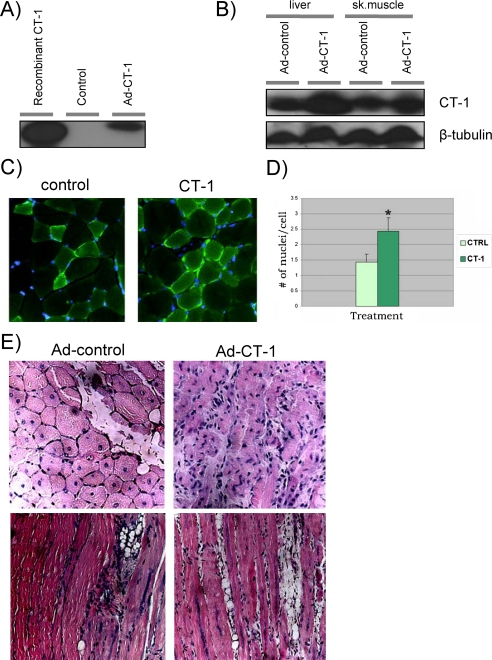FIGURE 7.
CT-1 delays regeneration of damaged skeletal muscle in vivo. A, immunoblotting was used to verify the efficacy of Adenovirus CT-1 production. Recombinant CT-1 protein (100 ng) was used as a positive control as well as media from CT-1 adenovirus infected myocytes. At 72 h post-infection, the media from the treated and untreated cells was collected and subjected to Western blotting analysis with a CT-1 antibody. B, at 7 days post-injection, skeletal muscle (sk.muscle) and liver samples were excised from adenovirus-injected mice. Frozen tissue was homogenized and a total of 300 μg of protein was electrophoresed on a 15% SDS-PAGE. An equal protein loading was verified by Western blotting analysis using β-tubulin specific antibody. C, at 7days post-injection, skeletal muscle was excised, fixed then embedded in paraffin, and sectioned at 10 μm. These sections were counterstained with hematoxylin and eosin to visualize the nuclei and cytoplasm. For immuno-histological detection of α-actinin, the sections were incubated with α-actinin antibody (Abcam), then incubated in donkey-anti-goat CY3 antibody (Chemicon) and finally counterstained with 4′,6-diamidino-2-phenylindole (Sigma). The micrographs were representative fields. D, 5 fields of view per section and 5 sections per TA muscle were analyzed. Differences between Ad-CT-1 and Ad-CTRL-injected samples were evaluated for statistical significance using one tailed, unpaired Student's t test. Differences were considered statistically significant at a p value less than 0.05. (n = 3). E, B6C3F1 mice were subject to systemic delivery of the CT-1 adenovirus. The injections were administered via intra-cardiac chamber delivery with 50 μl of Ad-CT-1 at a concentration of 3.0 × 108 plaque forming units/ml (n = 3). A control group of B6C3F1 mice were injected with 50 μl Ad-CTRL at a similar concentration (n = 3). In a separate group of animals, cardiotoxin was used to induce muscle injury immediately prior to AdCT-1 and Ad-CTRL injection (n = 3 for each group). 25 μl of 10 μm cardiotoxin (Latoxan) was injected directly into the TA muscle. 5 fields of view per section and 5 sections per TA muscle were analyzed. The micrographs presented are representative views. During post-recovery, mice were monitored closely for weight loss, dehydration, and cardiac distress.

